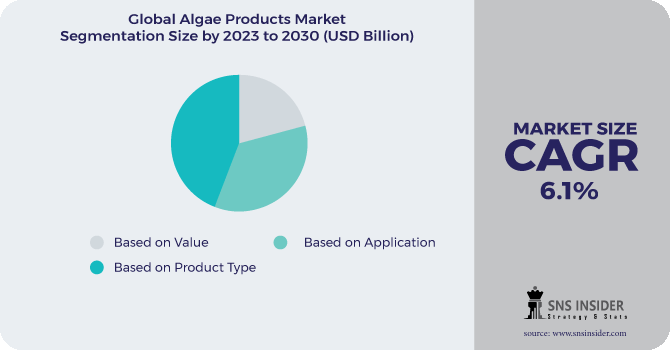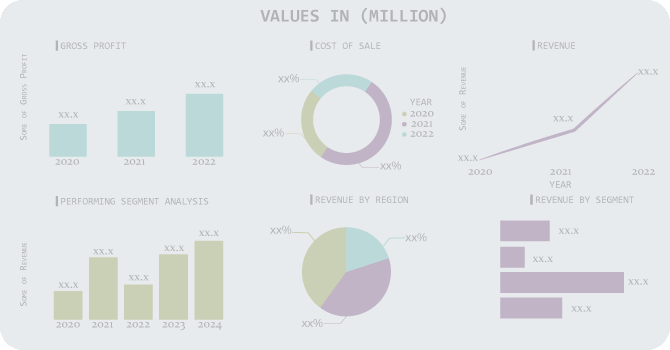Algae Products Market Report Scope & Overview:
Algae Products Market created US$ 4.98 billion in 2022 and is supposed to reach US$ 8 billion by 2030, developing at a CAGR of 6.1% from 2023 to 2030.
Algae are photosynthetic, oxygen-breathing microorganisms that can be unicellular or multicellular. These attributes help Algae in consuming carbon dioxide (CO2) and gathering significant minerals, nutrients, and supplements. The plant involves it as both fuel and food. Algae are regularly found in ocean growth, chlorella, and kelp-based Algae products. Algae products are high in protein and incorporate essential amino acids, which help in the improvement of human metabolic exercises like catalyst development.
.png)
The Algae products market is, to begin with, driven by the changing dietary inclinations among purchasers and the change in perspective toward preventive well-being the executives rehearse amid rising medical care costs and the rising weight of way of life-related infections.
The developing geriatric populace, combined with the rising commonness of persistent circumstances, is expected to drive the development of Algae products across the World. In addition, purchaser mindfulness about natural variations and their utilitarian properties has been a critical driver for the development. As it likewise upholds in-susceptibility improvement, the post-COVID-19 circumstance is anticipated to observe steep deals for the Algae supplements.
Market Dynamics:
Driving Factors:
-
Rising medical care costs all over the planet.
-
Expanding commonness and buyer mindfulness about omega-3 for preventive medical services.
-
The improvement of business results and Algae-based biofuel creation innovation.
Restraining Factors:
-
Absence of R&D exercises in immature nations.
-
Less awareness
Opportunities:
-
The ascent in the public authority and private drives supporting innovative work in hydroponics.
-
Developing interest in the drug business.
Challenges:
-
High creation costs limit the passage of more modest players.
-
The significant expense of creation and effect of climatic circumstances on the development of Algae.
Impact Of Covid-19:
The Covid-19 pandemic reasonably affected the Algae products market, because of interruption of the store network, the conclusion of assembling offices, and difficulties in the acquirement of natural substances.
Nonetheless, the interest for Algae products is supposed to ascend from here on out, attributable to an increment in shopper mindfulness about the advantages of Algae products and a flood in customer use on utilization of quality food products.
Market Estimations:
According to the worldwide Algae products market investigation, it is portioned into type, source, structure, application, and area. Contingent upon the type, the market is isolated into spirulina, chlorella, astaxanthin, beta carotene, and Hydrocolloids. Based on the source, it is arranged into earthy colored Algae, blue Algae, Red Algae, Algae, and others. By structure, it is bifurcated into strong and fluid. The application section involves food and drinks, nutraceuticals and dietary enhancements, individual consideration, compounds, feed, and drugs.
Key Market Segments:
Based on value:
-
Medium value
-
High value
-
Low value
Based on product type:
-
Hydrocolloids
-
Carotenoids
-
Omega-3 pufa
-
Spirulina
-
Chlorella
-
Others
Based on application:
-
Food and feed
-
Nutraceutical
-
Cosmetics
-
Chemicals
-
Others

Regional Analysis:
-
North America
-
USA
-
Canada
-
Mexico
-
-
Europe
-
Germany
-
UK
-
France
-
Italy
-
Spain
-
The Netherlands
-
Rest of Europe
-
-
Asia-Pacific
-
Japan
-
south Korea
-
China
-
India
-
Australia
-
Rest of Asia-Pacific
-
-
The Middle East & Africa
-
Israel
-
UAE
-
South Africa
-
Rest of Middle East & Africa
-
-
Latin America
-
Brazil
-
Argentina
-
Rest of Latin America
-
The North American Algae products market has been encountering gigantic development. The US gained the biggest portion of the North American Algae products market. Developing ventures, like food and drink, nutraceutical, drug, and dietary enhancement, have altogether added to the development of the Algae Products market in the US.
The rising populace in the nation is one more element that is supposed to help the interest in Algae products. An expansion in well-being cognizant shoppers has prompted the expanded utilization of lipids, for example, omega-3 in nutraceutical and dietary enhancement products, which has offered a market an open door for Algae-based omega-3 products.
Key Players:
Caldic B.V., Archer Daniels Midland Company, Cargill, Incorporated, DuPont de Nemours, Inc., TBK Manufacturing Corporation, Kerry Group Plc.
Cargill-Company Financial Analysis

| Report Attributes | Details |
|---|---|
| Market Size in 2022 | US$ 4.98 Billion |
| Market Size by 2030 | US$ 8 Billion |
| CAGR | CAGR 6.1% From 2023 to 2030 |
| Base Year | 2022 |
| Forecast Period | 2023-2030 |
| Historical Data | 2020-2021 |
| Report Scope & Coverage | Market Size, Segments Analysis, Competitive Landscape, Regional Analysis, DROC & SWOT Analysis, Forecast Outlook |
| Key Segments | • by Type (Chlorella, Spirulina, Other) • by Application (Poultry, Swine, Ruminant, Aquaculture, Other) |
| Regional Analysis/Coverage | North America (USA, Canada, Mexico), Europe (Germany, UK, France, Italy, Spain, Netherlands, Rest of Europe), Asia-Pacific (Japan, South Korea, China, India, Australia, Rest of Asia-Pacific), The Middle East & Africa (Israel, UAE, South Africa, Rest of Middle East & Africa), Latin America (Brazil, Argentina, Rest of Latin America) |
| Company Profiles | Caldic B.V., Archer Daniels Midland Company, Cargill, Incorporated, DuPont de Nemours, Inc., TBK Manufacturing Corporation, Kerry Group Plc. |
| Key Drivers | • Rising medical care costs all over the planet. • Expanding commonness and buyer mindfulness about omega-3 for preventive medical services. |
| Restraints | •Absence of R&D exercises in immature nations. •Less awareness |

